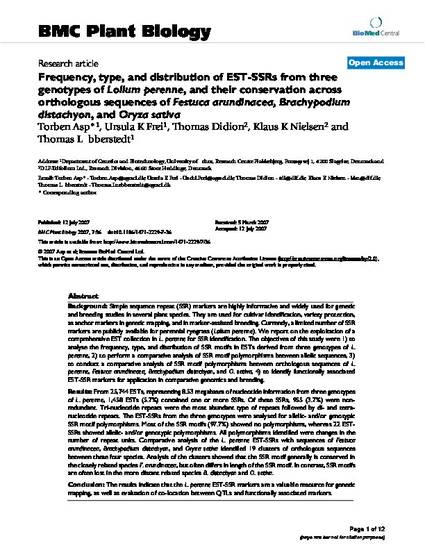
Article
Frequency, type, and distribution of EST-SSRs from three genotypes of Lolium perenne, and their conservation across orthologous sequences of Festuca arundinacea, Brachypodium distachyon, and Oryza sativa
BMC Plant Biology
(2007)
Abstract
Background
Simple sequence repeat (SSR) markers are highly informative and widely used for genetic and breeding studies in several plant species. They are used for cultivar identification, variety protection, as anchor markers in genetic mapping, and in marker-assisted breeding. Currently, a limited number of SSR markers are publicly available for perennial ryegrass (Lolium perenne). We report on the exploitation of a comprehensive EST collection in L. perenne for SSR identification. The objectives of this study were 1) to analyse the frequency, type, and distribution of SSR motifs in ESTs derived from three genotypes of L. perenne, 2) to perform a comparative analysis of SSR motif polymorphisms between allelic sequences, 3) to conduct a comparative analysis of SSR motif polymorphisms between orthologous sequences of L. perenne, Festuca arundinacea, Brachypodium distachyon, and O. sativa, 4) to identify functionally associated EST-SSR markers for application in comparative genomics and breeding.
Results
From 25,744 ESTs, representing 8.53 megabases of nucleotide information from three genotypes of L. perenne, 1,458 ESTs (5.7%) contained one or more SSRs. Of these SSRs, 955 (3.7%) were non-redundant. Tri-nucleotide repeats were the most abundant type of repeats followed by di- and tetra-nucleotide repeats. The EST-SSRs from the three genotypes were analysed for allelic- and/or genotypic SSR motif polymorphisms. Most of the SSR motifs (97.7%) showed no polymorphisms, whereas 22 EST-SSRs showed allelic- and/or genotypic polymorphisms. All polymorphisms identified were changes in the number of repeat units. Comparative analysis of the L. perenne EST-SSRs with sequences of Festuca arundinacea, Brachypodium distachyon, and Oryza sativa identified 19 clusters of orthologous sequences between these four species. Analysis of the clusters showed that the SSR motif generally is conserved in the closely related species F. arundinacea, but often differs in length of the SSR motif. In contrast, SSR motifs are often lost in the more distant related species B. distachyon and O. sativa.
Conclusion
The results indicate that the L. perenne EST-SSR markers are a valuable resource for genetic mapping, as well as evaluation of co-location between QTLs and functionally associated markers.
Disciplines
Publication Date
2007
DOI
10.1186/1471-2229-7-36
Publisher Statement
This article is published as Asp, Torben, Ursula K. Frei, Thomas Didion, Klaus K. Nielsen, and Thomas Lübberstedt. "Frequency, type, and distribution of EST-SSRs from three genotypes of Lolium perenne, and their conservation across orthologous sequences of Festuca arundinacea, Brachypodium distachyon, and Oryza sativa." BMC plant biology 7, no. 1 (2007): 36. 10.1186/1471-2229-7-36. Posted with permission.
Citation Information
Thomas Lubberstedt, Torben Asp, Ursula K Frei, Thomas Didion, et al.. "Frequency, type, and distribution of EST-SSRs from three genotypes of Lolium perenne, and their conservation across orthologous sequences of Festuca arundinacea, Brachypodium distachyon, and Oryza sativa" BMC Plant Biology Vol. 7 Iss. 1 (2007) p. 36 Available at: http://works.bepress.com/thomas-lubberstedt/10/
Creative Commons license

This work is licensed under a Creative Commons CC_BY International License.
